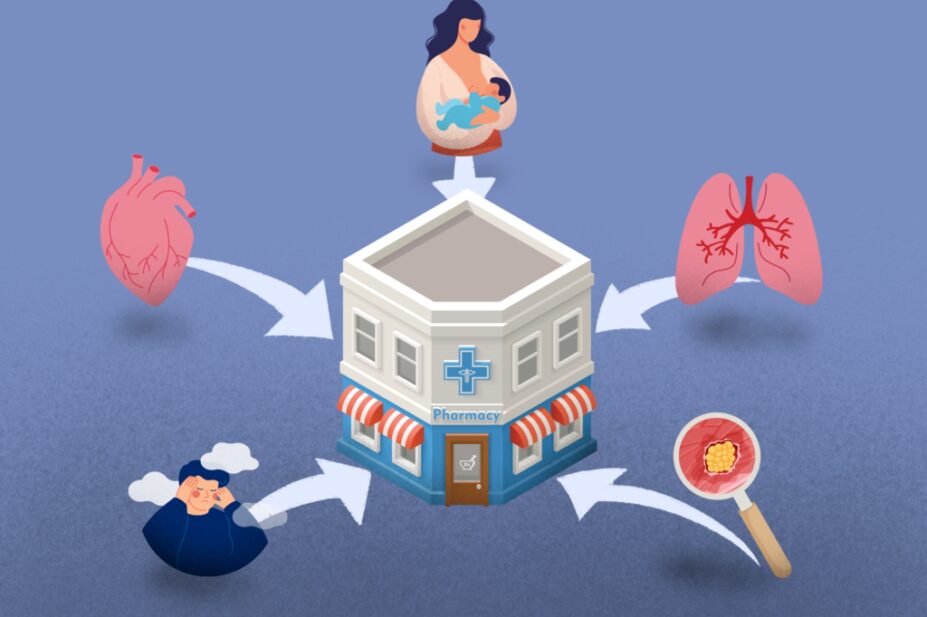
Shutterstock.com/The Pharmaceutical Journal
Inequalities run through our society in how healthcare is experienced, accessed and received[1]. Decades of research have found many reasons for this, including that 80% of the determinants of health are social rather than related to healthcare[2–4]. NHS England’s Core20PLUS5 is a national strategy to help develop services that reduce different aspects of healthcare inequalities from both national and local standpoints[5].
Core20PLUS5 aims to address health inequalities in five clinical areas in populations in the 20% most deprived quintile in England. These five areas are:
- Continuity of maternity care;
- Severe mental illness;
- Chronic respiratory disease;
- Early cancer diagnosis;
- Cardiovascular disease (CVD) case finding and management.
One approach to narrowing the healthcare inequality gap is to improve patient access to cost-effective healthcare innovations that increase quality of life or the quality of services for patients[6].
In 2022/2023, £4.2m was made available to integrated care systems (ICSs) through NHS England’s Innovation for Healthcare Inequalities Programme (InHIP) to support them in developing projects that improve access to the latest healthcare technologies and medicines, using a healthcare inequalities improvement approach that is in line with the Core20PLUS5 campaign.
We believe that pharmacy professionals can work collaboratively with integrated care systems to drive innovative services to reduce healthcare inequalities
Innovative projects in healthcare are critical to meeting the needs of patients. However, they can inadvertently exacerbate healthcare inequalities. For example, adopting an exclusively digital pathway risks exclusion of people with reduced access to and skills in digital technology. Adoption of health innovations that is slow, disproportionate to need and without a quality improvement approach means that healthcare inequalities seen in the UK will persist, or even widen.
The question is: how can this be avoided? We believe that pharmacy professionals can work collaboratively with integrated care systems to drive innovative services to reduce healthcare inequalities.
Unique role of pharmacy in innovation
Nearly 90% of the population in England has access to a community pharmacy within a 20-minute walk and we know that places with better access to community pharmacies are more likely to be deprived[7]. This means that pharmacies are well placed to house innovative services that reduce health inequalities. Pharmacy staff also have significant insight into the challenges faced by their community and the viability of potential services.
Several InHIP projects have actively demonstrated this.
One of the first steps for all projects commissioned through InHIP was to gather local population health management insights, such as for those in the 20% most deprived quintile, ethnic minority groups or coastal communities, to decide which communities to focus on. These data were analysed alongside insights from the local community, including patient and carer voices, to shape the project design and delivery.
Using this approach, Birmingham and Solihull ICS established hypertension diagnosis and medicines optimisation as a priority area, particularly among the 20% most deprived communities and ethnic minority groups. Local engagement demonstrated that community pharmacies are trusted by these groups and, in some cases, are more accessible than established CVD pathways. As a result, the Birmingham and Solihull InHIP team worked closely with the local pharmaceutical committee to involve community pharmacists in the three most deprived primary care networks in hypertension case finding and management.
One community pharmacist in the area has produced videos on blood pressure checks in the five most commonly spoken languages in Birmingham to improve service accessibility among ethnic minority groups when the English language may be a barrier.
Inequalities also exist in the detection and management of hyperlipidemia and many patients in high-risk groups are unaware of their cardiovascular risk, particularly among the 20% most deprived communities, ethnic minority groups and people aged 18–39 years.
Taking a proactive primary prevention approach through community pharmacy may also reduce the risk of secondary disease
In South East London ICS, pharmacists aimed to tackle this by piloting a service to improve access to all lipid management medications for patients requiring treatment escalation or alternatives for statin intolerance, alongside reducing cardiovascular risk.
The ‘Protect your heart’ hub was run by an experienced independent prescribing pharmacist specialising in lipid management in one of the ICS’s most deprived neighbourhoods. Patients from GP practices hosting the hub are actively identified using the UCLPartners ‘Proactive care framework’, which is for patients with CVD who are not currently treated to cholesterol targets. Referrals are also taken from other practices outside of the hub and secondary care specialists. Patients are then invited for a clinical review, recruited into the service and followed up at regular intervals.
Pharmacy staff are involved throughout the process, including in drug procurement, medicines adherence support within community pharmacy, and during education, training and specialist support from the CVD specialist, pharmacists in local hospitals and the integrated care board.
Positive benefits to patients with healthcare inequalities are already being seen, including improved access to and uptake of lipid management medications, alongside additional monitoring.
This project demonstrates the benefits of a pharmacist developing their experience and expertise in comorbidity management, producing positive outcomes for cardiovascular risk reduction and empowering patients to take positive actions to protect their own wellbeing.
Taking a proactive primary prevention approach through community pharmacy, particularly for CVD in this programme, may also reduce the risk of secondary disease requiring increased use of primary and secondary healthcare services.
Supporting pharmacists to develop services
InHIP demonstrates the importance of pharmacy when designing services aimed at improving care for patients included in the Core20PLUS5 populations.
As a wider reflection, there is an opportunity for national pharmacy and innovation leadership to explore the role pharmacy professionals play in innovation development and transformation, whether through the Centre for Pharmacy Postgraduate Education Quality Improvement learning programme, or support programmes, such as the NHS Clinical Entrepreneur Programme (CEP) and NHS Innovation Accelerator programmes.
Pharmacy is underrepresented in programmes that aim to develop and scale promising solutions and innovations in the health service
For many pharmacists, particularly the 62% that work in community pharmacy in England, their role and responsibility will require a level of entrepreneurial thinking through ownership or management of a pharmacy premises[8]. Despite this, pharmacy is underrepresented in programmes that aim to develop and scale promising solutions and innovations in the health service.
For example, application data for the NHS Clinical Entrepreneur Programme in 2022 demonstrated a significant difference between applications received from pharmacists (5%, n=8) compared with doctors (68%, n=202).
There may be several reasons for this difference, but the relatively low number of submitted applications from pharmacy professionals does prompt the need for further support for innovation practice in the pharmacy profession.
Pharmacy professionals are leaders in their systems, with the knowledge, skill and platform to highlight their value in discussions around resource allocation to support local Core20PLUS5 population groups in accessing services. InHIP has demonstrated the desire and need for upskilling healthcare colleagues in reducing inequalities. A national evaluation of InHIP is due in summer 2024 and may offer further insights and transferable learning opportunities.
Further resources
- The NHS Clinical Entrepreneur Programme is open to all NHS staff who have an innovative idea to improve healthcare. Click here for more information and to see future application openings;
- Pharmacy professionals interested in the delivery of CVD prevention activities locally may wish to join the Inclusive Pharmacy Practice CVD Prevention Community of Practice for collaboration opportunities, support and resources by contacting and indicating interest to: england.pharmacyintergration@nhs.net
- 1Buck D, Lewis T. NHS England and tackling inequalities: times are changing. The King’s Fund. 2021. https://www.kingsfund.org.uk/blog/2021/12/nhs-england-and-tackling-inequalities (accessed November 2023)
- 2HANCOCK T. Lalonde and beyond: Looking back at “A New Perspective on the Health of Canadians”. Health Promot Int. 1986;1:93–100. https://doi.org/10.1093/heapro/1.1.93
- 3Dahlgren G, Whitehead M. The Dahlgren-Whitehead model of health determinants: 30 years on and still chasing rainbows. Public Health. 2021;199:20–4. https://doi.org/10.1016/j.puhe.2021.08.009
- 4Magnan S. Social Determinants of Health 101 for Health Care: Five Plus Five. National Academy of Medicine. 2017. https://nam.edu/social-determinants-of-health-101-for-health-care-five-plus-five/ (accessed November 2023)
- 5Core20PLUS5: An Approach to Reducing Health Inequalities. NHS. 2021. https://www.england.nhs.uk/wp-content/uploads/2021/11/core20plus5-online-engage-survey-supporting-document-v1.pdf (accessed November 2023)
- 6Life Sciences Vision. HM Government. 2021. https://assets.publishing.service.gov.uk/government/uploads/system/uploads/attachment_data/file/1013597/life-sciences-vision-2021.pdf (accessed November 2023)
- 7Todd A, Copeland A, Husband A, et al. The positive pharmacy care law: an area-level analysis of the relationship between community pharmacy distribution, urbanity and social deprivation in England. BMJ Open. 2014;4:e005764–e005764. https://doi.org/10.1136/bmjopen-2014-005764
- 8Survey of registered pharmacy professionals 2019. General Pharmaceutical Council. 2019. https://www.pharmacyregulation.org/sites/default/files/document/gphc-2019-survey-pharmacy-professionals-main-report-2019.pdf (accessed November 2023)


